Own housing is part of the well-being and stability of any happy Russian (and not only) family. However, not always people are ready to buy a finished house or apartment. Such a purchase can be overshadowed by a number of significant drawbacks: the inconvenience of planning, too large (or too small) square footage of the room. In addition, the family may already have land on which to build their own housing. That is why many people decide to build a frame house with their own hands. A step-by-step guide on how to do this in the best possible way will be presented in this article.
And indeed, the construction of your own housing is not an easy and time-consuming task. Before you start building a home, you should weigh all the pros and cons of such an idea. You also need to have the necessary skills and abilities. How to build a frame house with your own hands correctly? Where to begin? What tools to prepare? The answers to these and many other questions can be found in this article. Howeverfirst, let's decide whether it is worth building a frame house on our own.
Good side of this idea
Before you figure out how to build a frame house with your own hands, you need to understand the benefits of such an event. What do people who have already built their own homes say?
Firstly, such builders note that the construction of frame buildings is a relatively inexpensive option for acquiring personal real estate. Secondly, it is also considered a positive thing that the future owners themselves take care of the materials for the structure, that is, they use only what they themselves wish. However, this nuance can also be attributed to the disadvantages of frame buildings, since not all people are willing to spend a lot of time and effort on purchasing everything you need.
The next positive thing about building a home with your own hands is that with proper preparation, the construction process will go relatively quickly. As experienced people say, a simple structure can be built without haste and special skills in just one month. In addition, such construction does not involve the participation of numerous highly qualified craftsmen. It only takes two people to build a home, and they don't have to be professional builders.
However, the main advantage of frame housing is that the interior design and layout of rooms can be designed in accordance with your taste and preferences. This is especially liked by future housewives who not only want to do their ownthe home is convenient and comfortable, but also invest a part of yourself in it, endow the house with a special atmosphere.
Negative aspects of the project
Thinking about how to build a frame house with your own hands, you should also take into account the disadvantages of this event. As mentioned above, the responsibility for the materials used (including the quality of work) lies with the future owners. Are they ready for the fact that it is necessary to allocate enough time for the design of the building, the purchase of materials and tools, the implementation of certain construction works? If not, then you can contact specialized companies that build turnkey frame houses.
Ask for help
This is very convenient, since not the owners of future real estate, but professional builders, will be involved in the construction of the dwelling. At the same time, the owners of the house can choose the building of the required layout and size.
Very often Russians apply for such services to the company "Build and Live". Building frame houses with this company is very easy and inexpensive. The company already has some experience in the construction of wooden houses. Many were satisfied with the quality of services and the cost of work.
The company has its own official website, as well as a YouTube channel, where you can see photos and videos of ready-made structures. Also, the guys teach others how to build a frame house with their own hands. Photo reports of the company help not only to decide on the choice of the project, but also to see the quality and good quality of the work performed.
However, many decide to build a houseyourself.
Purchase materials
So, we are building a frame house with our own hands. Where can you start the construction process? It is best to calculate the costs in advance and consider what materials and tools you need to purchase.
For example, we are building a 6x6 frame house with our own hands. What needs to be prepared? First of all, let's write a list of necessary materials for pouring the foundation:
- Two sand machines.
- 8mm rebar - 88 meters.
- Concrete - 8 m3.
- Film 170 md. - 1 roll.
- Anchors - 10 pieces.
- PGS - 1 car.
- Grid (100х100х5) - 1 roll.
- Rebar 12 mm - 150 m.
- Post a/c 150 mm - 8 pieces.
For the construction of the frame, first of all, boards are needed. They should be purchased in different sizes:
- 38 x 140 - 6m3.
- 38 x 90 - 2m3.
- 38 x 230 - 7m3.
- 40 x 150 - 2.5 m3.
- 40 x 200 - 2m3.
Also, for the construction of the frame, you need to purchase plywood of different thicknesses:
- 9 millimeters - 52 sheets.
- 12 millimeters - 42 sheets.
- 18 millimeters - 25 sheets.
In addition, the following materials should be purchased:
- Roofing material - 2 rolls.
- Shinglas roof - 100 m2.
- Colored iron - 3 sheets.
- Nails for special pneumatic chute.
- Shinglas nails - 15 kg.
- Staples - 350 pieces.
- Izospan AM - 3 rolls.
- Windows.
- Mounting foam - 4 pieces.
The above amount of materials is relative and depends on the abilities of the master and other nuances.
However, this is not all that needs to be purchased. In addition to the walls and foundation, the frame building must be insulated, as well as take care of the exterior finish and communications.
For insulation, you can use mineral wool (approximately 15 m3) and drywall (about 90 sheets), as well as film and self-tapping screws.
What to use for exterior decoration? Experienced builders recommend using decorative stone. For our house of 6x6 m, it is necessary to take twenty cubic meters of this material. Additionally, you should purchase glue for the stone in the amount of seven bags, mesh (about 20 m2), grout (7 packs), siding (about 90 m2), soffit (25 m2), as well as profiles and hardware. Don't forget to build a drainage system as well.
The internal communications of a frame dwelling include water heating, electrical wiring, plumbing and, of course, sewerage.
So, we are building a frame house with our own hands. We have already decided on the materials and their quantity. Now we turn to the direct construction of the dwelling. Where to start?
Preparing the land
How to build a frame house with your own hands? A step-by-step demonstration of the necessary work will be presented later in the article.
It all starts, of course, with the preparation of the site and the layout of the house. What needs to be considered at this stage of work?
First of all, it is necessary to clear the land allotted forconstruction of a dwelling, from debris and vegetation. If the building will be erected on a site with a slope, then the ground can be leveled using special equipment.
Next, the foundation should be marked, for which pegs are placed along the perimeter, indicating internal and external walls and corners.
Preparing the foundation
To help those who build a frame house with their own hands, a phased demonstration of construction work, presented below in the video.
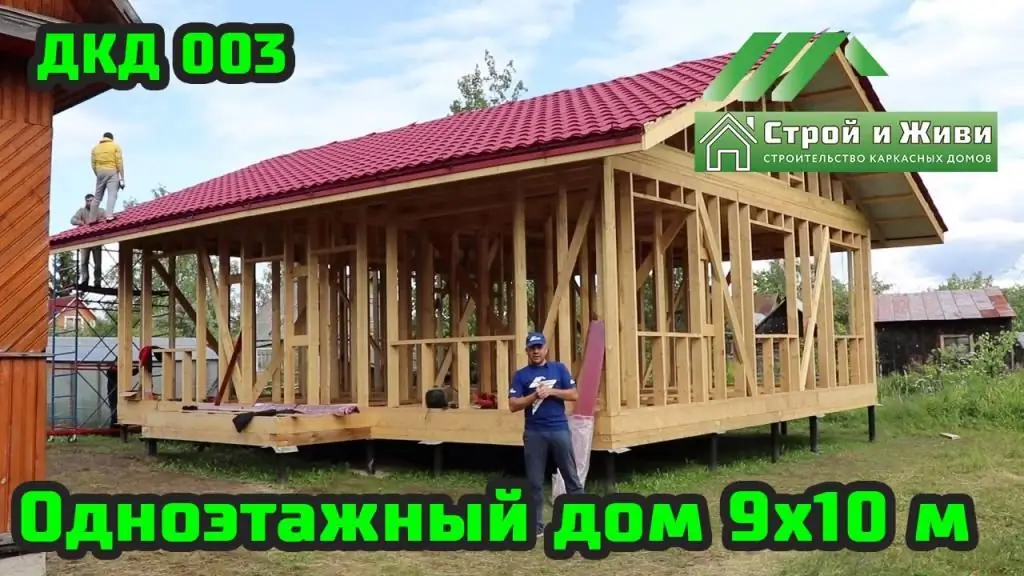
What should be considered when pouring the foundation? For frame construction, a pile, pile-grillage or tape base is used. However, experts recommend stopping at the second type, since it is the easiest to build, does not require complex calculations or large material investments. In addition, such a foundation is reliable and provides a uniform load on all supports.
For primary work, it is necessary to purchase TISE piles, which are famous for their strength due to the lower expansion. Wells can be drilled under them both manually and with the help of special tools. How to build formwork? It is necessary to roll the roofing material into pipes in three layers and secure with adhesive tape. Or you can use PVC pipes. Inside each pile, three or four reinforcement bars should be installed, connected together in the form of a square or triangle. How long should the rods be? At least 0.75 meters of reinforcement should rise above the surface of each pile.
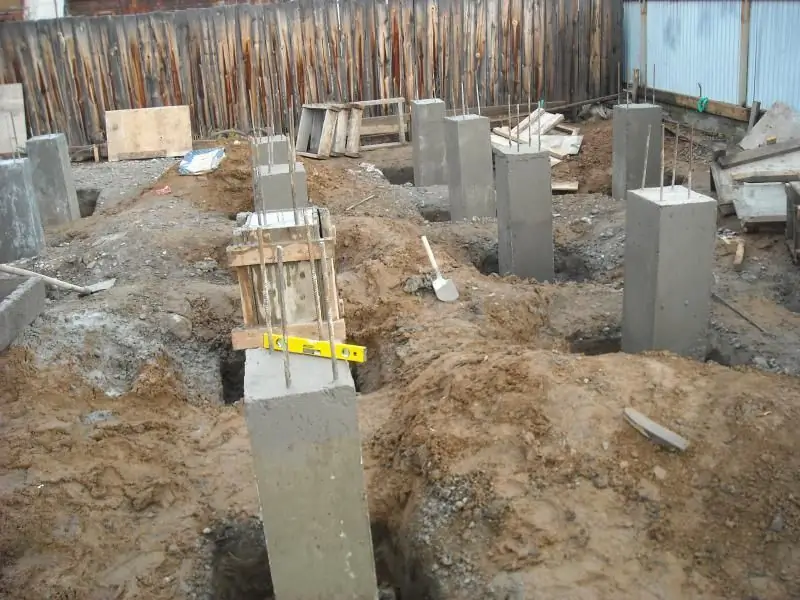
As soon as the formwork is ready, it is necessary to pour the entire surface with concrete.
AfterTo do this, it is necessary to install a rotswerk (in other words, a formwork for the tape), where it is necessary to connect the longitudinal bars together with the ends of the reinforcement, looking out of the piles. It is also necessary to insert segments of plastic pipes across the tape to design communication and ventilation units.
Along the perimeter of the tape, every two meters, it is necessary to fix the studs that will connect the future frame of the house and the poured foundation. A strapping load will need to be attached to these devices. Next, the structure is poured with concrete.
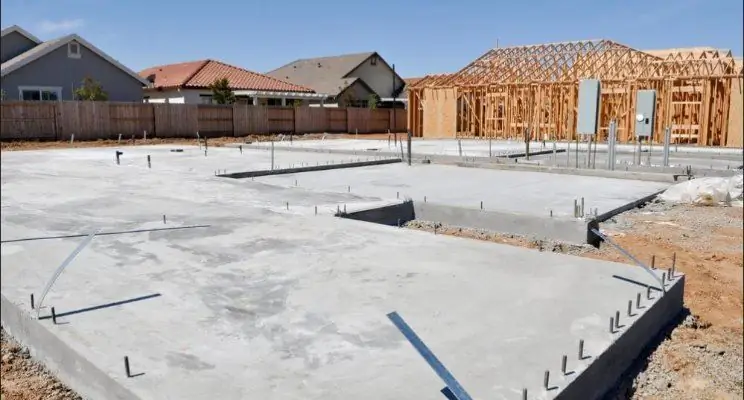
So that the solution does not dry out, but gain strength, it is recommended to cover the foundation with plastic wrap and leave for five to ten days, depending on the air temperature.
What to do after pouring concrete?
When the mortar is already well dried, you can think about waterproofing the foundation so that the wood does not draw moisture out of it. In this case, two layers of bituminous mastic or rolled waterproofing are used, less often - roofing material, as it can deteriorate over time.
The next layer on the tape is laid boards impregnated with special compounds. These are the so-called beds. Boards are recommended to be arranged in two tiers in such a way as to overlap the formed joints. In order to strengthen the beds on the studs, narrow holes should be drilled in them. It is also desirable to fasten two tiers of boards together with long nails, which are nailed every twenty centimeters.
Setting lag
A board is nailed to the installed bed,ribbed around the entire perimeter. Its edges are aligned along the edge of the foundation and nailed to the bed with long nails (nine centimeters) every forty centimeters.
Then, lags are installed, which are the same boards placed with an edge across the strapping. They are nailed to it on both sides (right and left) with two oblique nails. Logs are installed every forty to sixty centimeters. Experienced craftsmen recommend: the longer the boards, the shorter the distance between them should be. In some cases, you can optionally install a cross beam.
Making the floor
We continue to build a frame house with our own hands. The photos and recommendations presented in the article will help you build the structure in the correct sequence.
So, the logs are installed, let's move on to the flooring. Let's do some insulation first. Here you can use expanded polystyrene plates (with a density of at least fifteen kilograms per cubic meter). The thickness of the insulation should reach 15 centimeters. Plates are best placed in two levels so that the joints do not coincide with each other.
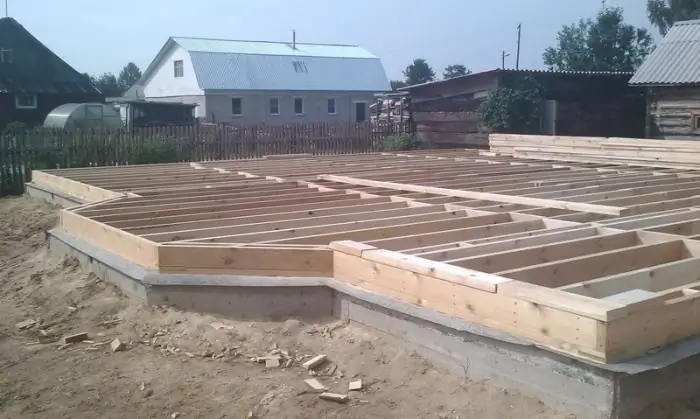
A long bar 5x5 centimeters must be nailed along the bottom edge of the wooden logs. This will serve as a support for the slabs.
Then we cut the foam plastic with a regular hacksaw. Masters advise to make the edged edges even. To do this, use a metal file. After the insulation is installed, the seams between the foam and the strapping are filled with sealant.
A subfloor is laid on top of the slabs of boards, and on top of it -plywood five or six millimeters thick. When placing the boards, look at their cross section: the annual rings, which go in a semicircle, should alternate, that is, look up and down. Some people refuse a layer of boards in favor of plywood, at least one and a half centimeters thick.
When placing sheets in several layers, it is necessary to pay attention to the fact that the joints between them do not coincide. Next, we fix the plywood with self-tapping screws. Along the perimeter, we maintain a distance between the screws of 12 centimeters, inside - about 40 centimeters, fastening is done in a checkerboard pattern.
Building the frame
Before proceeding to this stage of assembling a residential building, it is necessary to decide how further work will be carried out: the frame will be assembled in a separate place, and then mounted on the floor, or the walls will be erected directly on the foundation, gradually. What is more convenient and easier for the master - he chooses himself.
Fixing racks
The dimensions of the boards should be chosen taking into account future loads, as well as the width of the insulation. For one-story buildings, they acquire racks with a parameter of 100 x 100 millimeters, for two-story buildings - 150 x 150 millimeters. The depth of the intermediate racks should be no less than the corner ones, but the thickness can be less - from 50 millimeters.
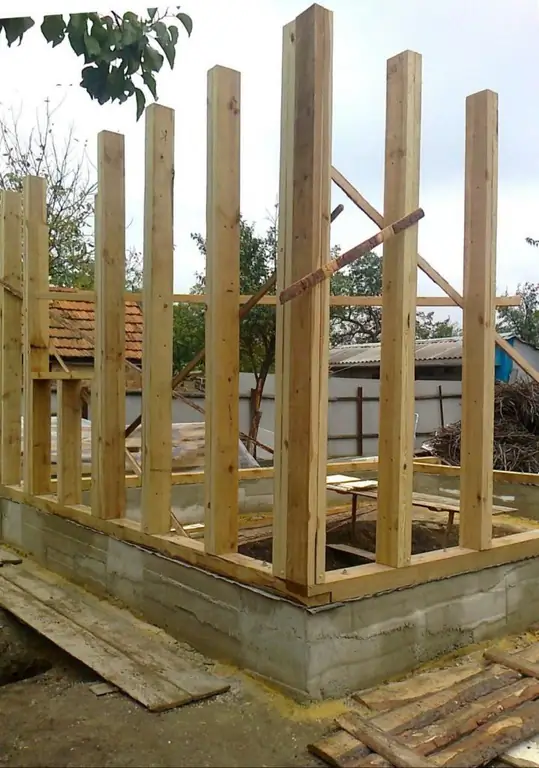
The distance between the supports should be equal to the width of the insulation and usually varies around sixty centimeters. The height of the racks is equal to the height of the draft ceiling minus fifteen centimeters.
Howfasten these wooden elements? Masters advise two ways: by corners (that is, from both sides of the bars) or by cutting (to the bottom board).
Where the windows and doors will be, double beams are attached, as the load on them will be greater.
Additional elements on piles
Since the erected supports will “walk”, they are fixed between themselves with temporary diagonal braces. In some cases, it will be advisable to install two small jibs on top and bottom of the wooden beams. If it is planned to have fragile wall cladding, for example, typesetting, then such elements should be left.
After that, you can build walls, that is, sheathe piles with plywood or OSB.
Making overlaps
Beam overlappings are supported by the bars of the upper trim. How to connect these structures with each other? This can be done in three ways: using perforated staples, reinforced corners, or cutting one board into another.
So, at the top along the perimeter of all walls we nail a board, then we install beams, which are also called ceilings. The size of the boards and the distance between them depends on what will be on top - the second floor or the attic.
Rafter system
Next, we build the roof of a frame house with our own hands. First you need to decide on the type of roof. It is best to build a gable or mansard roof in a frame house. It is necessary to carry out calculations and purchase material depending on the type of roof.
It is necessary to fasten the rafter legs along the very edge of the floor beams. You can fix the rafters with temporaryjib.
What dimensions should the wooden elements be and at what distance is it recommended to install them? According to the regulations, the parameters of the rafters used affect the installation step. For example, rafters three meters long and 40 x 150 mm are recommended to be installed at a distance of sixty centimeters from each other. If three-meter beams 100 x 150 millimeters are used, then the installation step increases to 2.15 meters. In other cases, four-meter rafters with parameters of 50 x 150 or 100 x 200 millimeters can be selected. In this case, the distance between them must be maintained at 0.6 and 2.15 meters, respectively. And finally, the owner can purchase six-meter roof beams measuring 50 x 200 or 100 x 250 millimeters. Then the installation step is 60 and 175 centimeters, respectively.
So, the rafters are installed, we move on to the crate, the step of which will depend on the roof slope chosen by the owner. For example, if the angle is fifty degrees, then the distance between the bars will reach 37.5 centimeters. If the selected slope angle does not exceed fifteen degrees, then the crate step will be 33 centimeters.
After the implementation of these works, it is necessary to make a counter-lattice.
Roof installation plan
Building a roof is a painstaking and serious business that requires the utmost care and precision. After the necessary materials have been purchased, work should begin, adhering to the universal plan below:
- Two boards that willserve as rafter legs, overlap at an angle of ninety degrees and fix with nails.
- The connected boards are placed on the Mauerlats. The edges of the rafters should extend half a meter beyond the level of the lower walls. This is required to install a gutter system.
- Next, you need to adjust the angle of the slope and nail a wooden bar between the rafter legs to fix the slope of the roof.
- Then, side rafters are mounted along the edges of the house.
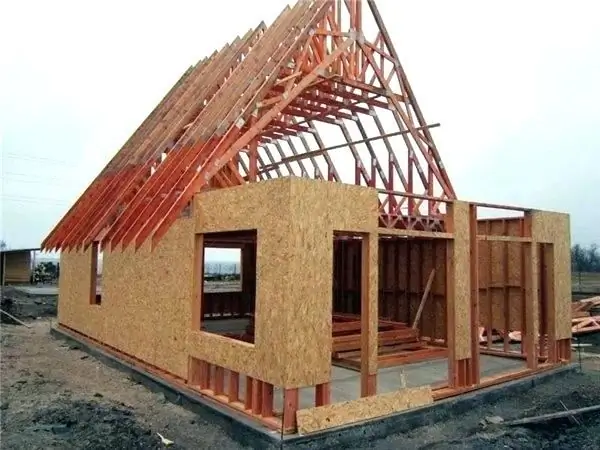
When the roofing system is installed, you can proceed to the insulation of the roof. To do this, a vapor barrier film is attached from the inside with a stapler. Then, between the wooden beams, it is necessary to install the plates of the selected insulation. On top of it, many masters recommend laying a reinforced film, and then a diffusion membrane.
The next step in the construction of the roof will be the lathing (often it is also necessary to install a counter-lattice). The final step will be the installation of the roofing. Most often they are metal tiles. Sheets are overlapped and fixed with self-tapping screws. The bottom edge of this covering should protrude approximately forty centimeters beyond the edge of the cornice.
How to insulate walls?
This is a very important question, because not only the beautiful appearance of your home depends on it. Warmth and comfort in the house are the result of properly selected materials for insulating the walls of the building.
How to sheathe the walls to make it warm and cozy? Experienced builders recommend after interior finishing with sheetsOSB use vapor barrier, as well as bas alt insulation with a thickness of at least 15 centimeters. Bas alt wool is best suited as this coating. Experts recommend purchasing it in the form of mats, not rolls. Although hard material will have to be additionally fixed with special clamps, it is more convenient and easier to work with it than with soft material.
Further, the bas alt insulation should be covered with a vapor-permeable membrane, which will act as protection from winds and moisture. Due to the fact that this material is not blown and does not pass water either in a gaseous or liquid state, your home will be warm and cozy.
After specialized insulation, it is necessary to do interior and exterior finishing work.
Interior decoration of the premises
Now our home can be given the desired look. Most likely, you have already planned out the rooms in your new home, and now you want to put things in order and make repairs. Are there any special recommendations on how to finish the interior of a frame house?
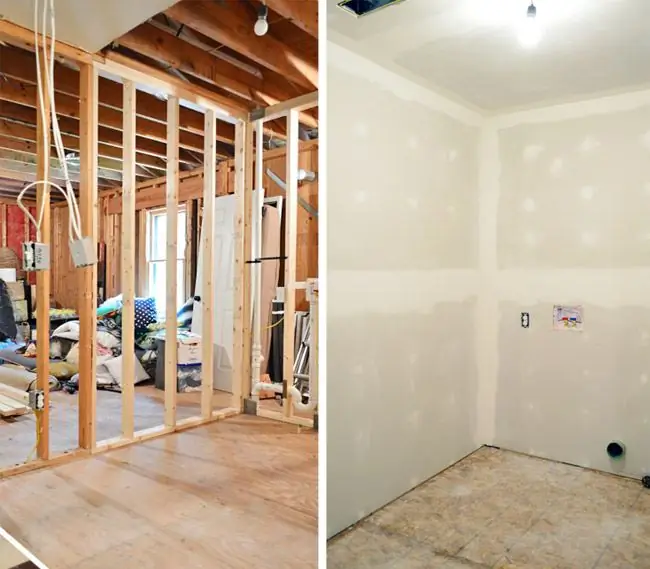
Of course not. It all depends on your imagination and taste. As mentioned above, OSB boards or drywall can be used for rough finishing. What materials are used for the so-called finishing?
The most different. It can be wallpaper of different types (paper, non-woven, vinyl or fiberglass), ceramic tiles, wooden lining made of plastic or natural wood, decorative plaster,flexible stone and so on.
You can lay linoleum on the floor, lay tiles or parquet.
Exterior trim
How to equip the facade of a new building? After the walls are carefully insulated, you can carry out external work to decorate the finished home. At the same time, many of the brightest and most unusual ideas can be realized. What are the best materials to use?
Most often, frame buildings are sheathed with a planed board (or block house), imitating log masonry. In doing so, the most modern surface treatment should be used to increase its moisture and fire resistance.
Also, very often, decorative plaster is used for facing a residential building. However, such work requires a lot of time and effort. What's more, a wet finish is short-lived.
Very often, frame houses are framed with plastic; vinyl siding is used for this. This material is inexpensive and easy to manufacture. Those who are not used to saving can use facade brick for exterior decoration - the most durable and effective material.
For insulation and cladding of the house, you can use thermal panels, as well as various modern materials (DSP sheets, Smart series panels, siding, marble chips, tiles imitating natural materials, and many others).
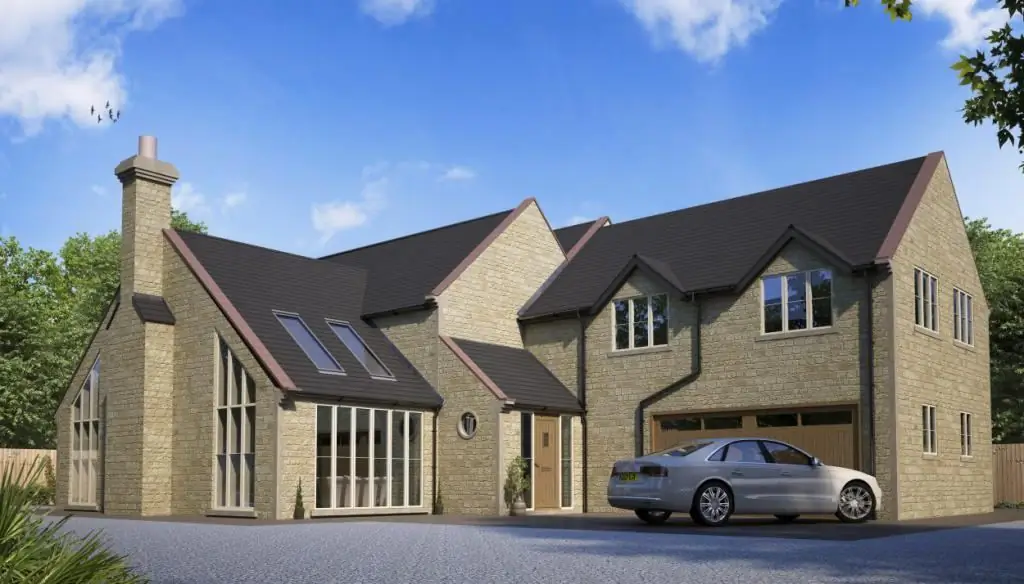
If additional buildings are needed
The frame house is built, but it is surrounded by a spacious empty yard? Many decide to use free space wisely anderect additional structures on their territory.
So, if necessary, we build a frame extension to the house with our own hands. What do you need?
First, you need to decide on the place where our additional building will be located. Then you should develop a project for the building and transfer it to paper. Further, with this drawing, you must contact the BTI to legalize the construction of our structure, otherwise it may be required to be demolished.
The next step will be the purchase of the necessary materials and tools. And then we start building.
The construction of a frame extension differs little from the construction of a frame house. Therefore, we act according to the principle described above:
- Pour a solid foundation.
- Setting lag.
- Filling the floor.
- Building a timber frame.
- Construction of walls and their insulation.
- Roof construction.
- Installation of door and window openings.
- External cladding.
- Interior decoration.
- And of course, don't forget about communications - electricity, plumbing and, if necessary, sewage.
As you can see, everything is not so difficult, especially considering the rich experience gained in the self-construction of a frame house.






